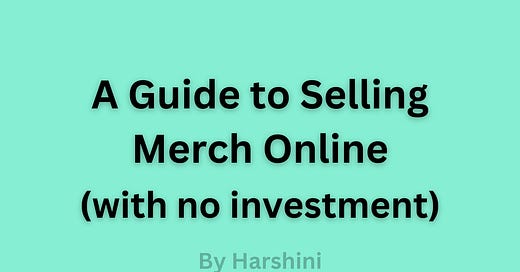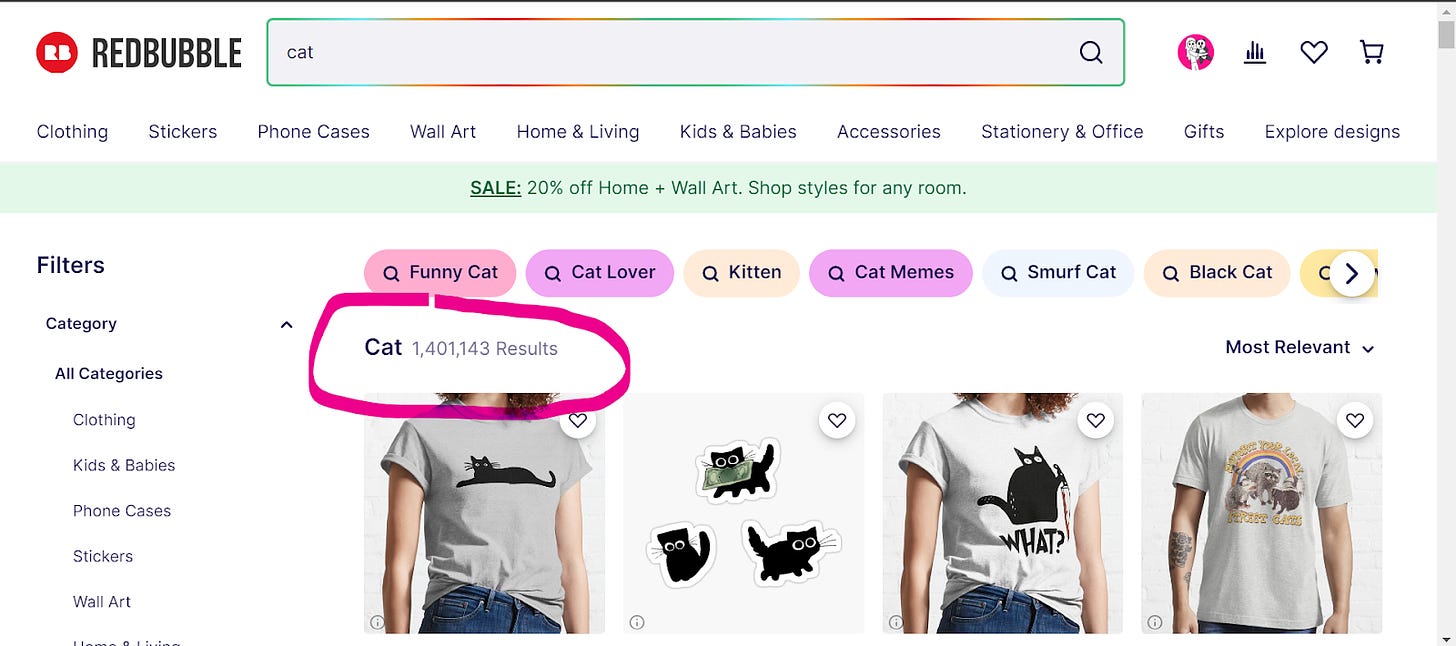A Guide to Selling Merch Online (with no investment)
How to start a print-on-demand business online. A guide with 10 tips for beginners
Hey there!
If you haven’t read the “I tried selling merch online (with no investment)”, This post is kind of like part two. You can read it by clicking this link for more context.
With that said, Here are some valuable things I learned when building my Print-on-demand shop.
I am using Redbubble as an example in this newsletter. But, these techniques can also be applied to other Print-on-demand platforms like Teepublic, Amazon merch, society6, etc.
How I create designs to sell on Redbubble:
So, as I mentioned in the previous newsletter, I am not a professional designer. I used a free website called “Canva” to create designs. Canva has a lot of copyright-free illustrations, texts, and photos on its website. If I am looking for a photo that is not available in Canva, these are my favorite websites for finding high-quality and royalty-free images:
Pixabay
Pexels
Unsplash
It’s best to avoid using copyrighted content and double-check if your designs have copyrighted elements before uploading them. I will share some tips on how to avoid copyright issues later in this article.
There are a lot of YouTube tutorials to learn how to use Canva. I recommend this channel for beginners.
Choosing a strategy that works:
From my observation, each Redbubble shop follows one of these five strategies.
A niche store that makes designs based on a specific topic.
A general store that has designs based on various topics.
An artist’s store. They create original artworks with their own art style.
A photographer’s store.
An officially licensed fan art shop.
Two of these strategies work for an absolute beginner: a niche store, and a general store. By following one of these two strategies, you can make sales even if you don’t have much artistic, design, or photography skills.
The key to selling using any strategy is that you have to find high-demand niches with low competition. “Cats” are a high-demand niche but there are more than 1.4 million cat designs on Redbubble.
It’s difficult to stand out among millions of other designs. But there is a way to stand out by doing something called “cross-niching”. Which is combining two niches to narrow down the competition.
For example, if you search for “Ginger cat”, you are competing against 13.3k designs, which is way less competition than before.
A general store (strategy):
A general store has designs on various topics that may not necessarily relate to each other. It's like having a YouTube channel where you upload gaming videos, cooking videos, and building construction videos all in one channel. I chose the general store strategy because I can upload whatever the heck I want and won’t run out of design ideas.
With this strategy, it is possible to create a store with thousands of designs that make a hundred dollars per month. But, it takes way too much time and hard work to get to that point. Also, to make it work, you have to do “niche research” and find the high-demand trend of the day before you start designing. Or your designs may not reach potential customers.
However, the general store strategy is not very effective if you are looking to build your “brand”. If you are looking to build an iconic POD shop, the products in your store must have a trait that makes people immediately recognize your brand.
If you already have an audience, whether they are on YouTube or Instagram, you have a huge advantage. Your shop will be recognized. you just have to introduce your online shop to your viewers. But if you don’t have viewers, learning SEO, conducting niche research, and advertising your products is the way to reach potential customers.
A niche store (strategy):
With a niche store, you create a shop with designs based on one topic (that you choose), for a specific group of people. For example, you could make cute cat designs for people who love cats.
No matter which strategy you use, you have to learn SEO (search engine optimization). This means you should learn how to get your products to show up on Google search results (or any other search engine). You can modify the titles, descriptions, and tags of your products to do that.
Here are 5 important things you need to keep in mind:
Be patient for 6 months:
You have to keep creating and uploading designs for at least 6 months before expecting to make sales. Whether you plan to upload twice a week or once a day, fix a schedule and follow through.
The basics of SEO:
Title, description, and tags are an important part. If you know how to title and tag your products properly, you can increase the chance of your products showing up in the search results. Use up to 15 tags and don’t use copyrighted words like celebrities' names or companies' names.
Consistently upload quality designs:
Your designs should have a high resolution and make aesthetic, cute, relatable, or funny designs.
Learn to place your designs on blank products:
make sure the design is placed on the products correctly. You can place a design on the center of a t-shirt. But if you placed the design on the center of a coffee mug, it won’t look good. It would be printed opposite to the handle. Place the design near the handle of the mug. Cause, that's how it is on most mugs.
Avoid copyright issues:
Don’t use copyrighted material in your designs. There are a lot of websites where you can find free and open-source photos and vectors for your designs. And don’t directly upload a downloaded design even if it's copyright-free. Modify it and add more elements like funny text to avoid copyright issues. Learn as much as you can about copyrights, fair use, and trademarks before opening your shop.
Here are a few more things you may need to know:
Humorous designs and original artworks sell like hotcakes:
Memeable, relatable, and aesthetic designs sell well.
A niche store gets more recognition than a general store:
This is just based on my speculation: people are more likely to share your shop with their friends if your shop has designs focused on one or two niches. Or if your designs have a unique art style.
Learn how to create designs suited for Redbubble products:
Make sure your design is in PNG format and has a transparent background. The ideal dimension for most Redbubble products is 4500 x 5400 with a high resolution. You may have to create an upsized version if you decide to enable the design on big products like tapestries or blankets. There are templates for each product on redbubble. If you want to design a bag, download the template for bags and use it to create the design.
Do research on best-selling designs before you design for products:
Analyze popular shops with bestselling designs. Why is that product selling well? Does it have a unique art style? Is it funny or relatable? What tags did the seller use on their products? Ask yourself these questions and try to find out why the popular products are selling well. Observe the featured artist on Redbubble.
Read the blog:
Each POD platform has a blog page where sellers can learn a lot of helpful tips on how to grow their shop. Read, learn, and apply what you’ve learned to your shop.
Here are 3 YouTube channels that helped me grow my POD shop:
Passive Owl: Passive Owl’s Redbubble tutorial videos kept me motivated. He uploads bite-sized Redbubble tutorial videos and gets straight to the point. He gives a lot of great tips for beginners.
Wholesale Ted: She teaches marketing and design tips. She also quickly finds out why a product is not selling and explains them in her videos. She also makes videos on how to design products even if you don’t know how to create designs.
Zen Watercooler: An honest YouTuber who does not make exaggerated claims or set unrealistic expectations. He also has another channel called “Crafty Stax” where he shares design tips and websites where we can find free and open-source design materials.
Check out my Redbubble shop:
Thank you for reading! I hope you enjoyed reading this post and hope it was helpful. Come again next week on Friday for a ✨new post✨
Recommended newsletters to read next:
I tried selling merch online with no investment (and how you can too)





